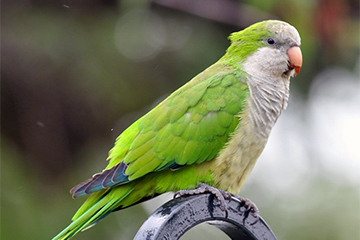
Monkeying Around
Back in the 1960s, the Monk Parakeet (also known as a Quaker) became a darling of the exotic bird trade, coveted for its small size, intelligence and exceptional talking skills. By the late sixties, over 16,000 birds a year were being captured from the wild and imported to the US. By the time pet trade restrictions were put in place, over 65,000 Monk Parakeets called America home.
If you live in an urban area of Florida, home to over 35,000 of them, you probably have a local flock of these electric green parakeets communally nesting atop one of their favorite destinations, a utility pole.
Today, there are established populations in over 50 Floridian counties, including Tampa, St Petersburg, Jacksonville, Bradenton and Ft Lauderdale. Flocks can often be seen flying overhead or peppering lawns looking for seeds and bugs. These feral parrots have learned to communicate by screeching and can often be heard coming from a block away.
So why are these cute, intelligent parrots (that “we” brought into the country) now being deemed invasive and watched by the US Fish & Wildlife Service, utility companies and farm bureaus?

Well, the fears may have originated from their history in South America where they became serious agricultural pests—as unlike most parrots, which predominately eat seeds, Monk Parakeets also love fruit, berries, nuts, grains and insects. These feeding preferences wreaked economic havoc in South America—with some grain fields and fruit orchards loosing up to 40% of their annual harvest.
As Monk Parakeets have a taste for citrus, one can understand why US Fish & Game and Floridian farm bureaus may be paying attention, but so far, Florida-based Monk Parakeets have not been reported to be on par with their South American marauding counterparts as they prefer urban to rural areas.
So, what other concerns have they raised? It appears that they have one habit that seriously annoys municipal governing bodies and utility companies. And that is their preference to build their enormous nests in urban structures, such as utility poles, silos and fire escapes.
Monk Parakeets are the only member of the parrot family to build stick nests and to nest colonially. Their nest structure, typically containing 20 or more nest chambers, is akin to an apartment complex. Nests can be very large (often 5 feet or more in length) and weigh over a ton as they are works in progress that are gradually added to for years.

As city governments and utility companies can attest to, electricity and sticks do not play well together and can (and do) result in nest fires—which are catastrophic for the Monk Parakeets and cause damage to electrical lines resulting in power source interruption.

To date, the power company remedy has simply been to destroy the nests, but this may be a loosing battle as the determined parakeets quickly rebuild them. The good news for all of us parrot lovers is that although over the last decade the Monk Parakeet population in the US has stayed steady, it has not grown significantly, so there are no longer active programs to control their numbers.
At BOPS, we have over 20 Monk/ Quaker Parakeets that provide much welcomed splashes of color, sounds and antics for our staff, visitors and fellow feathered residents. If you would like to make a donation for their care or provide sponsorship for them, we thank you in advance.




